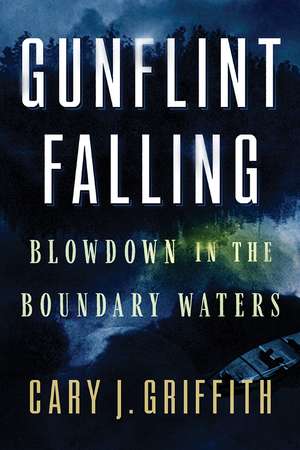Gunflint Falling: Blowdown in the Boundary Waters
Autor Cary J. Griffithen Limba Engleză Paperback – 19 noi 2024
On July 4, 1999, in the Boundary Waters Canoe Area Wilderness (BWCAW), a bizarre confluence of meteorological events resulted in the most damaging blowdown in the region’s history. Originating over the Dakotas, the midsummer windstorm developed amid unusually high heat and water-saturated forests and moved steadily east, bearing down on Fargo, North Dakota, and damaging land as it crossed the Minnesota border. Gunflint Falling tells the story of this devastating storm from the perspectives of those who were on the ground before, during, and after the catastrophic event—from first-time visitors to the north woods to returning paddlers to Forest Service Rangers.
The pre-dawn forecasts from the National Weather Service in Duluth for that Sunday of the holiday weekend predicted the day would be “warm and humid. Partly sunny with a thirty percent chance of thunderstorms.” But as the afternoon and evening settled over the Boundary Waters, the first eyewitness accounts began to tell a dramatic and terrifying story. Five friends camping on Lake Polly watched in wonder as the sky turned green and the winds began to whip. They scrambled to pull canoes on shore and secure tarps when a tree snapped and struck one of them in the head, rendering her unconscious. Three women enjoying their last day of a camping trip near the end of the Gunflint Trail took shelter in their tent as winds increased. Water drenched the nylon walls as trees crashed around them, one flattening the tent and pinning a woman beneath its weight. A family vacationing at their cabin dodged falling trees and strained against straight-line winds as they sprinted from the cabin to the safest place they knew: a crawl space underneath it. They watched in awe as trees snapped and toppled, their twisted root balls torn out of the water-logged earth—as they prayed their cabin would hold.
By the time the storm began to subside, falling trees had injured approximately sixty people, and most needed to be medevacked to safety. Amazingly, no one died. The historic storm laid down timber that would later blaze in the Ham Lake fire of 2007, ultimately reshaping the region’s forests in ways we have yet to fully understand.
Preț: 95.85 lei
Nou
Puncte Express: 144
Preț estimativ în valută:
18.34€ • 19.10$ • 15.50£
18.34€ • 19.10$ • 15.50£
Carte indisponibilă temporar
Doresc să fiu notificat când acest titlu va fi disponibil:
Se trimite...
Preluare comenzi: 021 569.72.76
Specificații
ISBN-13: 9781517915575
ISBN-10: 1517915570
Pagini: 312
Ilustrații: 13 maps
Dimensiuni: 140 x 210 x 20 mm
Greutate: 0.34 kg
Editura: University of Minnesota Press
Colecția Univ Of Minnesota Press
ISBN-10: 1517915570
Pagini: 312
Ilustrații: 13 maps
Dimensiuni: 140 x 210 x 20 mm
Greutate: 0.34 kg
Editura: University of Minnesota Press
Colecția Univ Of Minnesota Press
Notă biografică
Cary J. Griffith has written three nonfiction books, including Lost in the Wild, Opening Goliath, and Gunflint Burning: Fire in the Boundary Waters (Minnesota, 2018). His novels include Wolf Kill, Cougar Claw, and Killing Monarchs. He is the recipient of a Minnesota Book Award and a Midwest Book Award.
Recenzii
"Cary J. Griffith makes full use of his impressive talents for interviewing people to obtain truly interesting and previously unknown perspectives and details on the 1999 blowdown. He skillfully weaves these interviews into a complex and captivating story that conveys how incredible this event was and why it deserves a prominent place in Minnesota’s history."—Lee E. Frelich, director, Center for Forest Ecology, University of Minnesota
"In the tradition of The Perfect Storm, Cary J. Griffith brings readers into the Boundary Waters moment by moment as an epic gale sweeps through. Ample maps and in-depth interviews with witnesses both immerse us in one terrifying day and offer a glimpse of the past and future of Minnesota’s boreal forest."—Kim Todd, author of Sensational: The Hidden History of America’s “Girl Stunt Reporters”
"In Gunflint Falling, Cary J. Griffith provides an accurate, comprehensive narrative of those impacted by one of the region’s most devastating storms. The damage and pain brought by the derecho storm was more severe than anything previously experienced in the Boundary Waters Canoe Area Wilderness. The reader is taken into the personal experiences of the injured and those searching for them for fourteen days in the million-acre wilderness, and Griffith’s narrative of these experiences demonstrates how, when faced with an emergency, we come together to help one another."—Jim Sanders, retired forest supervisor, Superior National Forest (1996-2011), USDA Forest Service
"In the tradition of The Perfect Storm, Cary J. Griffith brings readers into the Boundary Waters moment by moment as an epic gale sweeps through. Ample maps and in-depth interviews with witnesses both immerse us in one terrifying day and offer a glimpse of the past and future of Minnesota’s boreal forest."—Kim Todd, author of Sensational: The Hidden History of America’s “Girl Stunt Reporters”
"In Gunflint Falling, Cary J. Griffith provides an accurate, comprehensive narrative of those impacted by one of the region’s most devastating storms. The damage and pain brought by the derecho storm was more severe than anything previously experienced in the Boundary Waters Canoe Area Wilderness. The reader is taken into the personal experiences of the injured and those searching for them for fourteen days in the million-acre wilderness, and Griffith’s narrative of these experiences demonstrates how, when faced with an emergency, we come together to help one another."—Jim Sanders, retired forest supervisor, Superior National Forest (1996-2011), USDA Forest Service
